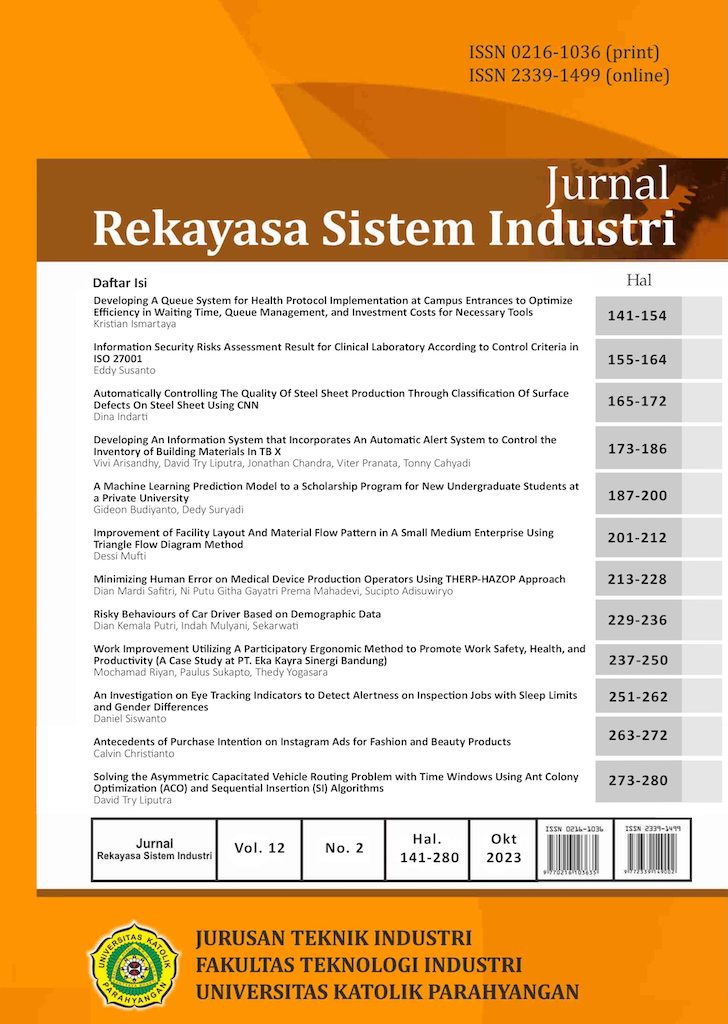Work Improvement Utilizing A Participatory Ergonomic Method to Promote Work Safety, Health, and Productivity (A Case Study at PT. Eka Kayra Sinergi Bandung)
DOI:
https://doi.org/10.26593/jrsi.v12i2.6784.237-250Keywords:
occupational safety and health, participatory ergonomics, productivity, work systemsAbstract
The needs of employees in their work are driven by the need for a safe, comfortable, and peaceful work environment to achieve maximum productivity. Productivity in the production activities at the PT. Eka Karya Sinergi production unit, which mainly produces lightweight steel products, is not yet optimal. Several factors can affect the productivity of workers at PT. Eka Karya Sinergi, including a less structured work system, ranging from occupational health and safety levels, work management, worker fatigue levels during the work processes, and complaints experienced by the workers. This research aims to improve the work system to enhance occupational health and safety as well as company productivity through a participatory ergonomics approach. The method used in this research is a qualitative descriptive approach. The occupational health and safety conditions were measured using two instruments, namely REBA and GOTRAK. The participatory ergonomics process was carried out through discussions using Focus Group Discussions. The results of the research show that through the improvement of the work system using the participatory ergonomics method, ergonomic hazards that were previously categorized as high-risk have been reduced to a safer category. This is evidenced by the process of assembling finished goods through the provision of new chairs, which resulted in a risk reduction of 12 points in the SNI 9011 score and 7 points in the REBA score. Furthermore, the improvement of work posture in the process of pumping handling coils with a handstaker resulted in a risk reduction of 4 points in the SNI 9011 score and 5 points in the REBA score. Additionally, the addition of a helper in the process of handling coil materials to the uncoiler machine can reduce the risk by 3 points in the SNI 9011 score and 5 points in the REBA score.
References
Badan Standardisasi Nasional (BSN). (2021). Keputusan Kepala Badan Standarisasi Nasional Nomor 590/KEP/BSN/12/2021 Tentang Penetapan SNI 9011:2021 Pengukuran dan Evaluasi Potensi Bahaya Ergonomi di Tempat Kerja. Jakarta.
Budiman, A., Husaini, H., & Arifin, S. (2016). Hubungan Antara Umur dan Indeks Beban Kerja dengan Kelelahan pada Pekerja di PT. Karias Tabing Kencana. Jurnal Berkala Kesehatan, 1(2), 121-129.
Burgess-Limerick, R. (2018). Participatory Ergonomics: Evidence and Implementation Lessons. Applied Ergonomics, 68, 289-293.
Della, R. H., Nugroho, B. S., Agustiawan, A., Simarmata, N., Fitriyani, E., Dewadi, F. M., ... & Sitorus, E. (2022). Kesehatan Dan Keselamatan Kerja. Era Society 5.0. CV. Eureka Media Aksara.
Hadiyanti, R., & Setiawardani, M. (2017). Pengaruh Pelaksanaan Program Keselamatan dan Kesehatan Kerja Terhadap Produktivitas Kerja Karyawan. Jurnal Riset Bisnis dan Investasi, 3(3), 12-23.
Hignett, S., Wilson, J. R., & Morris, W. (2005). Finding Ergonomic Solutions—Participatory Approaches. Occupational Medicine, 55(3), 200-207.
Julyanthry, J., Siagian, V., Asmeati, A., Hasibuan, A., Simanullang, R., Pandarangga, A. P., ... & Rahmadana, M. F. (2020). Manajemen Produksi dan Operasi. Yayasan Kita Menulis.
Kogi, K. (2006). Participatory Methods Effective for Ergonomic Workplace Improvement. Applied Ergonomics, Applied Ergonomics 37(4), 547-554.
Mahawati, E., Yuniwati, I., Ferinia, R., Rahayu, P. P., Fani, T., Sari, A. P., ... & Bahri, S. (2021). Analisis Beban Kerja Dan Produktivitas Kerja. Yayasan Kita Menulis.
Meithiana, I., & Ansory, H. (2019). Manajemen Sumber Daya Manusia. Indomedia Pustaka.
Middlesworth, M. (2015). A Step-by-Step Guide to the REBA Assessment Tool. Diakses November, 2022, dari https://ergo-plus.com/reba-assessment-tool-guide/
Moleong, L. J. (2019). Metodologi Penelitian Kualitatif. Remaja Rosdakarya.
Nobrega, S., Kernan, L., Plaku-Alakbarova, B., Robertson, M., Warren, N., Henning, R., & CPH-NEW Research Team. (2017). Field Tests of a Participatory Ergonomics Toolkit for Total Worker Health. Applied Ergonomics, 60, 366-379.
Notoatmodjo, S. (2018). Metode Penelitian Kesehatan, Cetakan Ke Tiga. PT Rineka. Jakarta.
Parinduri, L., Hasdiana, S., Purba, P. B., Sudarso, A., Marzuki, I., Armus, R., ... & Refelino, J. (2020). Manajemen Operasional: Teori dan Strategi. Yayasan Kita Menulis.
Prasnowo, M. A., Findiastuti, W., & Utami, I. D. (2020). Ergonomi Dalam Perancangan dan Pengembangan Produk Alat Potong Sol Sandal. Scopindo Media Pustaka.
Rost, K. A., & Alvero, A. M. (2018). Participatory Approaches to Workplace Safety Management: Bridging the Gap Between Behavioral Safety and Participatory Ergonomics. International Journal of Occupational Safety and Ergonomics, 26(1), 194-203.
Septiani, N. (2017). Beberapa Faktor yang Berhubungan dengan Perilaku Pekerja Dalam Penerapan Safe Behavior di PT. Hanil Jaya Steel. The Indonesian Journal of Occupational Safety and Health, 6(2), 257-267.
Simarmata, J., Makbul, R., Mansida, A., Rachim, F., Dharmawan, V., Bachtiar, E., ... & Della, R. H. (2022). Keselamatan dan Kesehatan Kerja. Yayasan Kita Menulis.
Sugiyono. (2016). Metode Penelitian Kuantitatif, Kualitatif, R&D. Bandung: IKAPI.
Sukapto, P., & Djojosubroto, H. (2013). Penerapan Peraturan Pemerintah No. 50 Tahun 2012 Tentang Sistem Manajemen Keselamatan Dan Kesehatan Kerja Untuk Meningkatkan Kinerja Industri Tekstil: Studi Kasus Pada Industri Tekstil Di Bandung. Research Report-Engineering Science, 2.
Susihono, W., & Gunawan, G. (2018). Design of Standard Operating Procedure (SOP) Based at Ergonomic Working Attitude Through Musculoskeletal Disorders (Msd’s) Complaints. In MATEC web of conferences, Vol. 218, p. 04019. EDP Sciences.
Van Eerd, D., King, T., Keown, K., Slack, T., Cole, D. C., Irvin, E., ... & Bigelow, P. (2016). Dissemination And Use of a Participatory Ergonomics Guide for Workplaces. Ergonomics, 59(6), 851-858.
Wilson, J. R., & Haines, H. M. (1995). Participatory Design in The Organisational Context. Global Ergonomics, 11-19.

